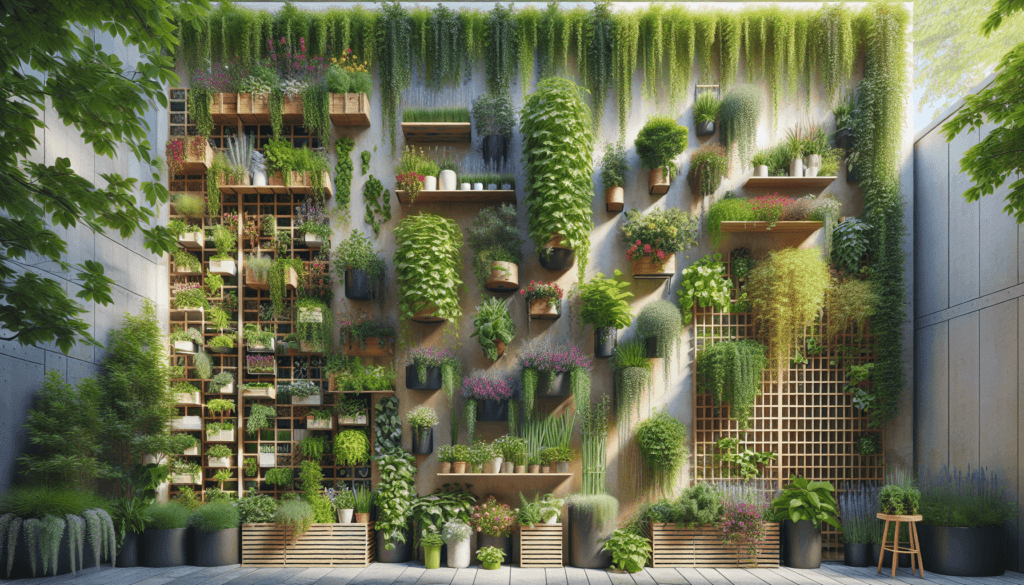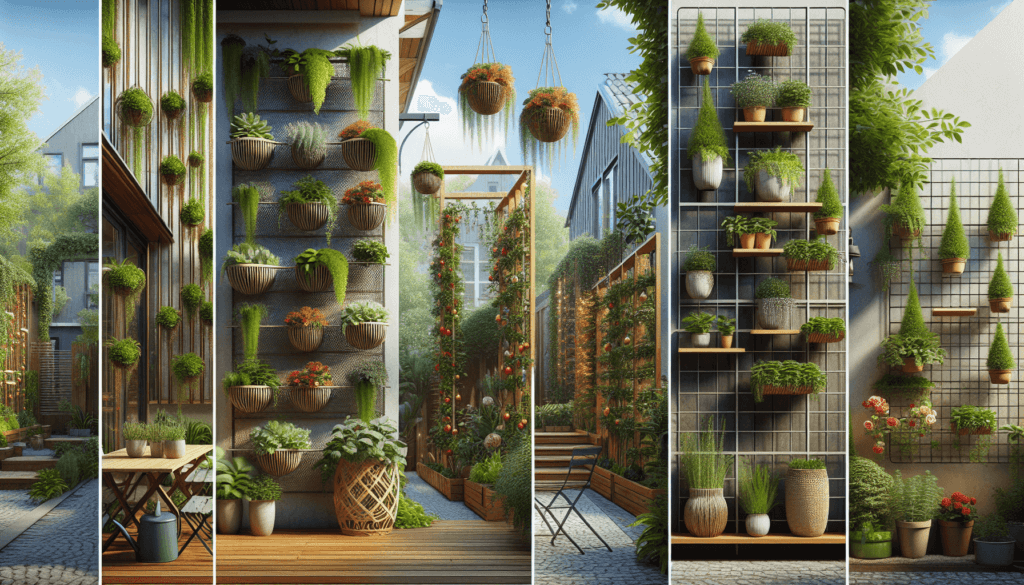Are you looking to make the most out of your urban garden? If you have limited space, utilizing vertical space can be a game-changer. Vertical gardening not only maximizes the available area but also adds a unique aesthetic appeal to your garden. This article explores some of the best ways to utilize vertical space in urban gardens, from installing vertical planters to using trellises and arbors. Discover how to create a flourishing oasis even in the tightest of spaces.
Vertical Gardening Structures
Arch Trellis
An arch trellis is a beautiful and functional vertical gardening structure that can add visual interest to your garden while maximizing vertical space. This structure consists of an arched frame with lattice panels or wires that provide support for climbing plants. By training the plants to climb up the trellis, you can create a stunning green wall that not only saves space but also adds a touch of elegance to your outdoor space.
A-Frame Trellis
Another popular vertical gardening structure is the A-frame trellis. As the name suggests, this structure resembles an A-shaped frame, with two sloping sides connected at the top. The A-frame trellis provides excellent support for climbing plants, allowing them to grow upwards and take advantage of unused vertical space. Whether you have a small balcony or a large backyard, an A-frame trellis can be a versatile and practical addition to your garden.
Vertical Pallet Planter
If you’re looking for a cost-effective and eco-friendly way to utilize vertical space in your garden, consider creating a vertical pallet planter. This DIY vertical gardening structure is made using recycled wooden pallets and can be easily customized to fit your space and planting needs. By attaching plant containers to the pallet slats and hanging the pallet vertically, you can create a vertical garden that is both functional and aesthetically pleasing.
Hanging Baskets
Hanging baskets are a classic and versatile way to grow plants vertically. By suspending baskets from hooks or brackets, you can make use of the vertical space in your garden or even on a balcony or windowsill. Choose trailing or cascading plants like petunias, ivy, or trailing geraniums to create a stunning display. Hanging baskets not only add beauty to your garden but also allow you to grow a wide variety of plants without taking up valuable ground space.
Climbing Plants
Cucumbers
Cucumbers are excellent candidates for vertical gardening due to their vining nature. By providing them with a trellis or vertical structure to climb on, you can save space and ensure that your cucumber plants receive optimal sunlight and airflow. Choose a sturdy trellis or netting system that can support the weight of the cucumbers as they grow. Vining cucumbers not only produce an abundance of fruits but also add a lush and vibrant look to your vertical garden.
Tomatoes
Tomatoes are another popular climbing plant that can thrive in a vertical gardening setup. By training tomato plants to grow upwards using stakes, cages, or trellises, you can prevent them from sprawling on the ground and taking up valuable space. Additionally, vertical tomato growing allows for better air circulation, reducing the risk of diseases and improving fruit quality. With their bright and juicy fruits, vertical tomato plants can be both a functional and visually appealing addition to your garden.
Beans
Beans, such as pole beans or runner beans, are perfect candidates for vertical gardening due to their climbing habit. These plants produce long and vigorous vines that can quickly cover a trellis or other vertical structure. Growing beans vertically not only saves space but also makes harvesting easier, as the pods are more accessible. Consider using a sturdy trellis or string system to provide support for the bean plants and enjoy a bountiful harvest of tender and delicious pods.
Peas
Peas are cool-season vegetables that can also be successfully grown vertically. Whether you choose snap peas, snow peas, or shelling peas, these climbing plants will appreciate the support of a trellis or netting system. By growing peas vertically, you can make the most of limited garden space and enjoy an abundant harvest of sweet and tender pea pods. Just make sure to choose a trellis with small enough gaps to allow the plants to grab onto it and climb up.

Container Gardening
Stacked Pots
One of the easiest ways to utilize vertical space in a small garden or balcony is by using stacked pots. This method involves stacking multiple pots vertically, with each pot containing a different plant. By using varying pot sizes and heights, you can create a visually appealing vertical garden that adds dimension to your space. Stacked pots are particularly useful for growing herbs, small vegetables, or flowers in a limited area.
Hanging Planters
Hanging planters are another fantastic option for vertical gardening in urban spaces. Hang your planters from hooks or brackets attached to a wall, balcony railing, or overhead structure and fill them with your favorite plants. From cascading plants with trailing foliage to vibrant flowers or even compact vegetables, the options for hanging planters are endless. Not only do they save space, but they also add a touch of charm and greenery to even the smallest of spaces.
Tiered Shelving
If you have a large collection of potted plants or want to grow a variety of plants in a limited space, consider using tiered shelving. By placing shelves at different heights, you can create a multi-level garden that utilizes vertical space efficiently. Choose shelving units made specifically for gardening or repurpose old furniture like wooden crates or ladders. Tiered shelving allows you to display your plants in an organized and visually appealing way while maximizing your growing area.
Wall-Mounted Systems
Pocket Planters
Pocket planters are a clever and space-saving solution for vertical gardening. These innovative planters feature pockets or compartments that can hold individual plants. Whether made from fabric, felt, or even recycled materials like soda bottles, pocket planters can be easily mounted on walls or fences. They’re perfect for growing herbs, small flowers, or even succulents, adding a touch of greenery to your vertical garden.
Vertical Wall Planters
Vertical wall planters are another attractive option for utilizing wall space in your garden. These planters typically consist of multiple pockets or containers that can be mounted on a wall, creating a stunning living wall. Some vertical wall planters even incorporate a built-in irrigation system, making plant care more convenient. With their versatility and aesthetic appeal, vertical wall planters can transform any plain wall into a vibrant and lush garden.
Living Walls
Living walls, also known as green walls or vertical gardens, are an exciting way to make use of vertical space while adding a striking visual element to your garden. These structures consist of a framework or panel system that holds plants in individual pockets or containers. Living walls can be freestanding or attached to a wall, and they can accommodate a wide variety of plants, including ferns, succulents, or even flowering plants. With their ability to purify the air and create a soothing ambiance, living walls are becoming increasingly popular in urban gardening.

Use of Espalier
Espalier is a technique that involves training fruit trees, vines, or shrubs into a flat, two-dimensional form against a wall, fence, or trellis. This technique allows you to make the most of vertical space by growing plants in a controlled and aesthetically pleasing manner. Espalier not only saves space but also promotes better sunlight exposure, airflow, and easier fruit harvesting. Apples, pears, peaches, and even roses are commonly grown using the espalier technique, creating a unique and beautiful focal point in any garden.
Overhead Structures
Pergolas
Pergolas are a stunning addition to any garden, providing both shade and vertical growing space. These structures consist of a series of vertical posts supporting an open roof made of evenly spaced beams. By training climbing plants, such as grapevines or wisteria, to grow up the posts and cover the roof, you can create a cozy and picturesque space underneath while utilizing vertical space above. Pergolas also offer a beautiful architectural element that can transform an ordinary garden into an enchanting oasis.
Arbors
Similar to pergolas, arbors are vertical structures often used to create shaded walkways or entrances to a garden. These structures feature an arched or rectangular shape and typically have an overhead lattice or trellis on which climbing plants can grow. By incorporating an arbor into your garden, you can add height, depth, and visual interest while providing support for climbing plants. Whether adorned with fragrant roses or vibrant clematis, arbors can be a charming and functional addition to any garden.
Gazebos
For a more substantial overhead structure, consider adding a gazebo to your garden. Gazebos are freestanding structures with a roof and open sides, providing shade and a sheltered area for relaxation or entertaining. By training climbing plants to grow up the columns or trelliswork of a gazebo, you can create a vertical garden that enhances the beauty and privacy of this outdoor space. With their elegant design and versatility, gazebos offer a perfect blend of function and aesthetics.

Incorporating Hanging Plants
Hanging plants are a fantastic way to utilize vertical space while adding a touch of charm to your garden. Hanging planters or baskets can be suspended from a variety of structures, including pergolas, arbors, gazebos, or simply hooks attached to walls or fences. Using a mix of trailing plants like ivy, ferns, or petunias, you can create a lush and whimsical atmosphere in your vertical garden. The key is to choose plants with trailing or cascading habits that will create an appealing vertical display.
Vertical Hydroponics
Vertical hydroponics is a modern and space-efficient way to grow plants without soil. In this system, plants are grown in vertical towers or panels that are irrigated with a nutrient-rich water solution. By utilizing this vertical setup, you can maximize your growing area, grow plants faster, and even save water compared to traditional soil-based gardening. Vertical hydroponics is particularly suitable for growing leafy greens, herbs, or strawberries in limited spaces, such as balconies or small gardens.

Utilizing Window Sills and Balconies
Window Boxes
Window boxes are a classic and effective way to utilize window sills for gardening. These containers can be easily mounted on the exterior of windows, allowing you to grow plants without taking up any floor space. Window boxes are perfect for growing herbs, small flowers, or even vegetables within arm’s reach. Whether you live in an apartment or have a house with windows overlooking the street, window boxes provide a delightful opportunity to add greenery to your surroundings.
Balcony Rail Planters
If you have a balcony, don’t let the railing go to waste. Balcony rail planters are specifically designed to be attached to balcony railings, providing a convenient solution for vertical gardening in urban spaces. These planters come in various shapes and sizes, allowing you to grow an array of plants while saving precious balcony floor space. From vibrant flowers to fresh herbs or even compact vegetables, balcony rail planters can transform your balcony into a lush and productive mini-garden.
Herb Gardens
Window sills and balconies are also ideal spots to create miniature herb gardens. By using small pots or planters, you can grow your favorite herbs right where you need them – in your kitchen or just outside your door. Place the herbs on window sills or balcony surfaces, ensuring they receive adequate sunlight. Not only will you have easy access to fresh herbs for cooking, but you’ll also enjoy the delightful aroma and beauty they bring to your living space.
Maximizing Wall Space
Wall-Mounted Shelves
Maximizing wall space in your garden can be as simple as installing wall-mounted shelves. These shelves can be used to hold potted plants, herbs, or even small decorative items. By combining shelves at different heights, you can create an eye-catching display that optimizes vertical space while adding a touch of style to your outdoor area. Wall-mounted shelves are particularly useful for gardens with limited ground space or for those who prefer a more organized and structured garden design.
Vertical Herb Gardens
If you’re a herb enthusiast, why not create a vertical herb garden on a wall? This can be done by using wall-mounted planters or even repurposing materials like pallets with built-in pockets for planting herbs. A vertical herb garden not only saves valuable garden space but also makes it easier to access your favorite herbs when cooking. Choose a sunny wall and plant a variety of herbs with different growth habits and flavors to create a functional and visually appealing herb garden.
Pockets and Pouches
Pockets and pouches are a creative and space-saving solution for vertical gardening. These versatile containers can be made from fabric, felt, or even repurposed items like shoe organizers or cloth shoe racks. By attaching these pockets or pouches to a wall, fence, or trellis, you can create a vertical garden that accommodates a wide variety of plants. Whether you choose to grow succulents, flowers, or even small vegetables, pockets and pouches offer an inventive way to make use of vertical space while adding a unique touch to your garden.
Utilizing vertical space in urban gardens is crucial for maximizing limited areas and turning them into lush and productive oases. Whether you choose arch trellises, wall-mounted systems, overhead structures, or window sills, there are numerous ways to create beautiful and functional vertical gardens. By exploring the various options available and tailoring them to match your space and gardening goals, you can transform your urban garden into a vibrant and thriving haven. So get creative, make the most of your vertical space, and enjoy the beauty and abundance that vertical gardening can bring to your outdoor space.


